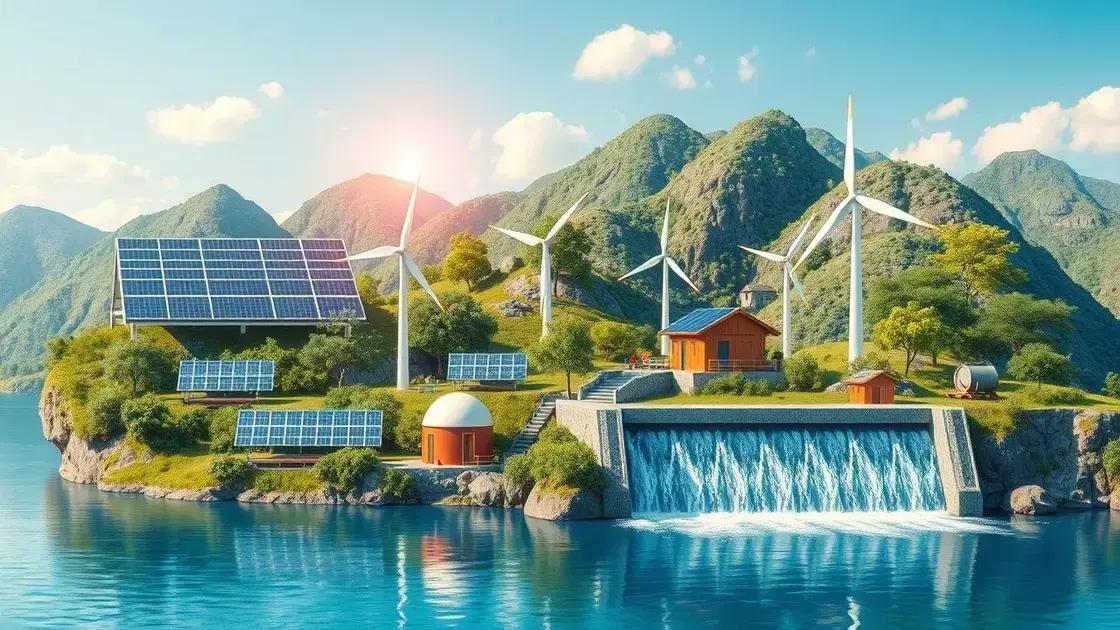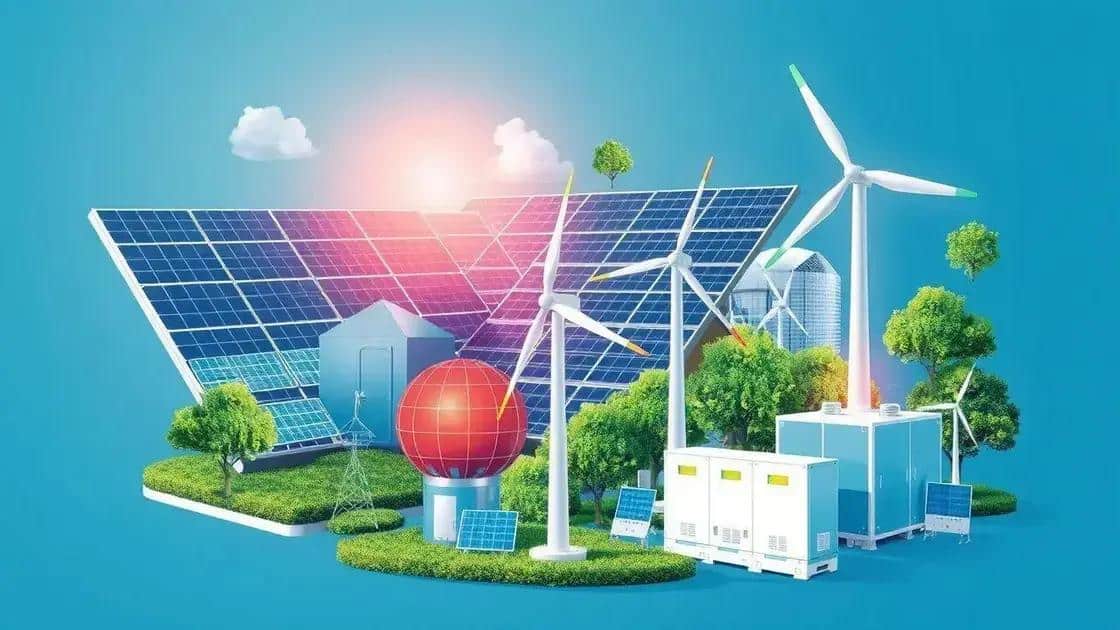Renewable energy expansion trends: what you need to know

Renewable energy expansion trends indicate a growing shift towards sustainable solutions, driven by technological innovations and community involvement, which enhances local economies and promotes cleaner environmental practices.
Renewable energy expansion trends are transforming the energy landscape as we know it. Ever wondered how these changes might influence your daily life? Let’s explore the driving forces behind this shift and what it means for everyone.
Current renewable energy policies shaping expansion
Current renewable energy policies play a vital role in shaping the expansion of clean energy sources around the world. It’s essential to understand how these policies influence our energy landscape and drive adoption.
Key Policies Impacting Renewable Energy
Several significant policies are paving the way for renewable energy growth. These measures support innovation and encourage investment in sustainable practices.
- Incentives and tax credits for solar and wind energy.
- Government initiatives for reducing carbon emissions.
- Regulations promoting energy efficiency in industries.
- Subsidies for research and development in new technologies.
The role of government regulations cannot be understated. They ensure that renewable energy technologies can compete with fossil fuels in pricing and accessibility. This increased competition leads to better prices for consumers and a shift toward greener alternatives.
Furthermore, many states and countries have implemented renewable portfolio standards (RPS). These standards mandate that a certain percentage of energy must come from renewable sources. This requirement encourages utilities to invest in wind, solar, and other sustainable energy infrastructures.
The Effect of International Agreements
International agreements also significantly influence national policies. For instance, the Paris Agreement has challenged countries to commit to reducing their emissions dramatically. Such commitments drive a global shift toward renewable energy technologies as nations race to meet their targets.
The collaboration among countries leads to shared resources and knowledge, accelerating innovations that can be adapted locally. As countries work together, the expansion of renewable energy sources becomes more achievable.
In summary, current renewable energy policies are essential in shaping a sustainable energy future. They encourage investments, promote cleaner technologies, and create a competitive market. This ongoing evolution will lead to a greener and more sustainable planet for all.
Technological advancements in renewable energy

The field of renewable energy is rapidly evolving, fueled by significant technological advancements. These innovations are making renewable energy sources more efficient and accessible than ever before.
Breakthroughs in Solar Technology
One of the most exciting areas of development is in solar technology. New materials and designs have resulted in solar panels that are not only more efficient but also more affordable.
- Perovskite solar cells are promising higher efficiency at lower production costs.
- Bifacial solar panels capture sunlight on both sides, maximizing energy output.
- Improved energy storage technologies enhance solar energy use even when the sun isn’t shining.
These advancements allow more households and businesses to harness the sun’s power, driving the growth of solar energy adoption.
Innovations in Wind Energy
Wind energy is also experiencing remarkable changes. Larger turbines and better designs are significantly increasing the amount of energy produced.
Modern wind turbines can now generate energy even in low-wind conditions, expanding the areas where wind farms can effectively operate. Additionally, offshore wind farms are becoming more common, harnessing stronger and more consistent winds over the water.
Smart technology is further enhancing wind energy systems. Monitoring systems track the efficiency of turbines in real-time, optimizing performance and ensuring maximum energy production.
Emerging Technologies
Other innovative technologies are also shaping the renewable energy landscape. Grid energy storage systems are crucial in managing energy supply and demand. These systems store excess energy generated during peak production times and release it when needed, ensuring a steady energy flow.
Hydrogen fuel is another area gaining attention. It can serve as a clean energy source, providing power for vehicles and industries while producing zero emissions.
As advancements continue, the future looks bright for renewable energy. With better technologies, we can expect to see a sustained shift toward cleaner energy sources, significantly benefiting our environment.
Impact of renewable energy on local economies
The impact of renewable energy on local economies is significant and wide-reaching. As communities adopt cleaner energy sources, they experience numerous positive changes.
Job Creation in Renewable Energy
One of the most immediate benefits is job creation. The renewable energy sector generates many jobs in various fields, including manufacturing, installation, and maintenance.
- Solar energy jobs are increasing due to the rise in solar panel installations.
- Wind farm development demands skilled workers for construction and upkeep.
- Energy efficiency programs create positions in consulting and auditing.
- Local economies see an influx of jobs, which helps reduce unemployment rates.
These job opportunities help families and improve community stability, enhancing the overall economy.
Boosting Local Businesses
Renewable energy projects can lead to increased business activity. Local suppliers and contractors often benefit from larger projects, helping them grow. When a solar farm or wind turbine is developed, it often requires local goods and services.
The presence of renewable energy can attract businesses looking for sustainable practices. More companies are choosing to set up operations in regions with robust renewable energy resources, leading to enhanced economic growth. This creates a cycle where renewable energy fosters further business development.
Energy Independence and Cost Savings
Communities that invest in renewable energy sources experience greater energy independence. As they generate their own power, they reduce reliance on imported fuels. This shift can lead to lower energy costs for residents and businesses alike.
Furthermore, local governments may see reduced energy expenses, allowing them to invest in community development projects. The savings can be redirected to essential services like education and infrastructure improvements, promoting overall community well-being.
As renewable energy infrastructures expand, the benefits for local economies will undoubtedly grow. The shift to clean energy not only contributes to environmental preservation but also lays the foundation for prosperous community development.
Future prospects for renewable energy sources

The future prospects for renewable energy sources are bright and promising. As technology advances and awareness grows, more people are pushing for clean energy solutions.
Technological Innovations Ahead
Upcoming innovations in renewable energy are expected to change the game. From better solar panels to advanced battery storage, these technologies will help maximize energy efficiency.
- Next-generation solar cells could enhance energy capture dramatically.
- Innovative wind turbine designs might produce more energy at lower costs.
- Energy storage solutions are set to keep energy available even when demand peaks.
- Smart grid technology will help manage energy distribution more effectively.
As these technologies develop, they will play a crucial role in shaping energy policies and consumer behaviors.
Global Trends Influencing Renewable Energy
Globally, there is a noticeable shift towards greener energy practices. Countries are setting ambitious targets to reduce carbon emissions and invest in sustainable energy sources.
Collaboration between nations is also increasing, sharing knowledge and resources to promote renewable energy. As countries come together to tackle climate change, the push for renewable energy will only strengthen.
Community Engagement and Growth
Communities are becoming more involved in sustainable practices. Local initiatives are emerging, focusing on reducing carbon footprints and promoting renewable energy projects. These grassroot movements inspire individuals to participate in energy conservation and renewable solutions.
The growth of electric vehicles and clean transportation options is influencing the demand for renewable energy. As more people adopt these technologies, the need for cleaner energy sources will rise, driving further investment in renewables.
Looking ahead, renewable energy sources will likely dominate the global energy market, setting the stage for a healthier planet. The sustainable future is not just necessary; it is achievable with continued innovation and community support.
FAQ – Frequently Asked Questions about Renewable Energy Expansion
What are the main benefits of renewable energy?
Renewable energy reduces reliance on fossil fuels, lowers greenhouse gas emissions, and creates job opportunities in local economies.
How does renewable energy impact local economies?
It leads to job creation, boosts local businesses, and enhances energy independence, ultimately leading to economic growth.
What technological advancements are shaping renewable energy?
Innovations such as advanced solar panels, larger wind turbines, and improved energy storage solutions are making renewable energy more efficient and accessible.
How can communities participate in renewable energy initiatives?
Communities can engage by supporting local renewable energy projects, advocating for sustainable practices, and adopting clean energy technologies like solar and wind.






